Overview
A banana is an edible fruit that belong to the genus Musa. The fruit is variable in size, color, and firmness, but is usually elongated and curved, with soft flesh rich in starch covered with a rind, which may be green, yellow, red, purple, or brown when ripe. The fruits grow in clusters hanging from the top of the plant.
In many cultures, bananas are a staple crop. Some plants are grown for ornamental qualities, but others are grown for their fruit and sold commercially. While most people are familiar with the sweet, elongated yellow fruits commonly sold in the grocery store, there are more than 1000 different banana varieties, of different sizes, shapes and colors. Some of the more unusual, uncommon varieties are available at health food and specialty grocery stores.
Varieties of Bananas
1. Cavendish Bananas
Cavendish bananas have been the classic lunchbox variety since the late 1950s. They’re long, slightly curved and cylindrical, with slightly pointed ends. Their skins are bright green when unripe and ripen to a bright golden yellow, gaining black freckles or spots as they continue to ripen. They have a classic banana flavor and are available year-round.

Characteristics
- Appearance: Long, cylindrical and slightly curved, with a slightly pointed end; bright green when immature and bright golden yellow when fully ripe
- Flesh: Creamy white flesh that’s firm when immature and becomes softer as it ripens
- Flavor: Sweet with a classic banana flavor
- Size: A medium banana is about 7 inches long
- Color: Bright green when immature, ripening to bright golden yellow
- Shape: Long, cylindrical and slightly curved
- Commonly Cooked: Yes
- Served Raw: Yes
- Seed: Some tiny, edible black seeds arranged down the center of the fruit
- Availability: Year-round
2. Burro Bananas
Burro bananas resemble the cavendish variety but are shorter and more square in shape. They have dark green peels that deepen to deep yellow with black spots when fully ripe. Their creamy white or yellow flesh has a lemony banana flavor when ripe and is slightly firmer toward the center.

Characteristics
- Appearance: Similar to a cavendish, but shorter and stubbier, with dark green peels that ripen to deep yellow with black spots
- Flesh: Creamy white to yellow, with a firmer center when ripe
- Flavor: Tart when immature; a lemony banana flavor when fully ripe
- Size: An average small banana is 6 inches long
- Color: Dark green; deep yellow with black spots when ripe
- Shape: Shorter and more square than a cavendish banana
- Commonly Cooked: Yes
- Served Raw: Yes
- Seed: Tiny, edible black seeds arranged down the center of the fruit
- Availability: Year-round from Mexico
3. Manzano Bananas

Manzano bananas are short and chubby with thick yellow skins that turn completely black when ripe. They’re sometimes called the apple banana because of their apple-like flavor when immature. When fully ripe, they have a more tropical, pineapple flavor.
Characteristics
- Appearance: Short and chubby with thick yellow skins spotted with brown; completely black when fully ripe
- Flesh: Cream colored; firm when immature and more creamy when fully ripe
- Flavor: A sweet, apple-flavored tang when immature, and a more tropical, pineapple flavor when fully ripe, with a characteristic apple fragrance
- Size: Finger-length
- Color: Yellow when immature; black when fully ripe
- Shape: Small and chubby, with a slight curve
- Served Raw: Yes
- Seed: Tiny, edible black seeds
- Availability: Year-round
4. Nino Bananas

Nino (or baby) bananas are short and stubby, about three inches long, and have thin green skins that turn bright yellow, with some black spots, when fully ripe. Baby bananas have a very dense creamy texture and once ripe their flavor is rich and sweet with vanilla and caramel undertones.
Baby bananas are a quintessential fresh eating banana and can be used as a dessert banana as well. Their sweetness lends to many recipes in various applications. Baby bananas can be a principle ingredient in smoothies, baby food, pudding, cakes, muffins, bread, cookies, ice cream and tarts.
Characteristics
- Appearance: Short and stubby, with thin green skins that turn bright yellow when ripe
- Flesh: Cream-colored to pale gold flesh with a dense, creamy texture
- Flavor: Rich, sweet, honey-like flavor
- Size: About 3 inches long
- Color: Green when immature; bright yellow, with some black spots, when fully ripe
- Shape: Similar to a classic banana shape, but shorter and more stubby
- Served Raw: Yes
- Seed: Tiny, edible black seeds
- Availability: Year-round
5. Red Bananas
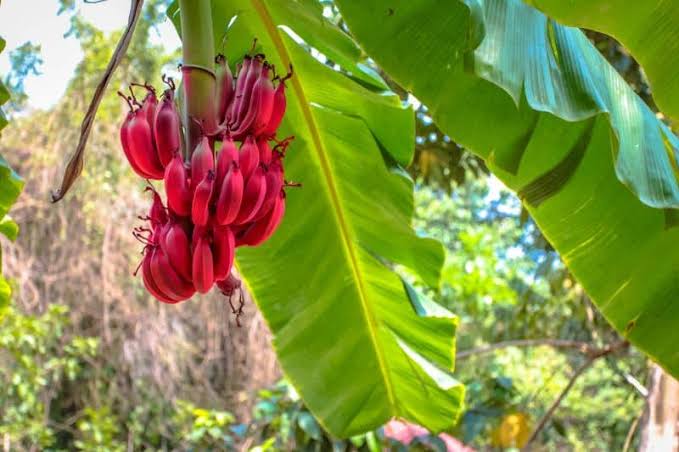
Red bananas have a purple or maroon-red skin that makes them a distinctive sight. They are squatter than a cavendish and its cream-colored flesh often has a light pink or pale orange hue. Sweeter than a traditional banana, they are a great choice to use for sampling with consumers. They are available year-round from Ecuador and Mexico.
Red bananas are shorter, plumper and heartier than the average banana. It should only be eaten when ripe as an immature Red banana taste’s like a dry and chalky starch. When ripe, it will have a thick, brick red peel and ivory-hued semi soft flesh. Its flavor is sweet and creamy with raspberry highlights.
Characteristics
- Appearance: Short and squatty with purple or maroon-red skin
- Flesh: Cream-colored flesh that often has a light pink or pale orange tinge
- Flavor: When ripe, sweet, with a slight raspberry flavor
- Size: Smaller than a common banana; 6 inches or shorter
- Color: Purple or maroon-red
- Shape: Shorter and squatter than a common banana
- Commonly Cooked: Yes
- Served Raw: Yes
- Seed: Tiny, edible black seeds
- Availability: Year-round
6. Pisang Mas Bananas
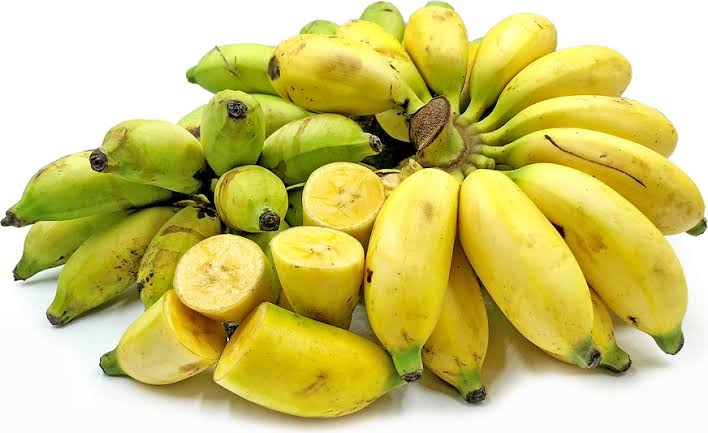
Pisang Mas bananas are small, squat, and straight to slightly curved in shape, averaging 2-3 centimeters in diameter and 10-14 centimeters in length. The tiny banana’s thin peel is green when immature and a vibrant yellow when ripe. The soft inner flesh matches the golden yellow hue of the outer skin and has a fruity aroma when peeled. Pisang Mas bananas are creamy and smooth with a sweet, honey-like taste.
Pisang Mas bananas are most popularly consumed raw but can also be used in cooked applications such as sautéing and baking. Sliced and used in fruit salads or peeled and consumed fresh as a snack, Pisang Mas bananas are favored for their ability not to turn brown when sliced. They can also be sautéed and caramelized as a topping for desserts and are commonly incorporated into stews and curries for added sweetness.
Characteristics
- Appearance: Small, squat
- Taste: Honey-like taste
- Size: 2-3 centimeters in diameter and 10-14 centimeters in length
- Color: Peel is green when immature but yellow when ripe
- Shape: squat, and straight to slightly curved in shape
- Commonly Cooked: Yes
- Served Raw: Yes
- Availability: Year-round
7. Rajapuri Bananas
Rajapuri bananas are small to medium-sized fruits, averaging 15 to 17 centimeters in length, and have a cylindrical, straight to slightly curved shape with pointed ends. The fruits form in large bunches, weighing up to 40 pounds, and grow in an upright pattern.
The skin is smooth and thin, easily peeled when ripe, and matures from bright green to golden yellow. Underneath the peel, the flesh is cream-colored, semi-firm, and dense, developing a creamy consistency when ripe and further transitioning into a chewy, mealy texture when overripe. Rajapuri bananas contain a high sugar content creating a balanced, sweet, and subtly tart flavor with mild, fruity, and vegetal undertones.
Rajapuri bananas are best suited for both raw and cooked applications, including baking, sautéing, frying, and boiling. The fruits can be used when green and unripe, incorporated into curries and stews, but the variety is primarily utilized ripe when the bananas contain a sweeter flavor. Rajapuri bananas can be eaten fresh, out-of-hand, blended into smoothies, sliced as a topping for ice cream, oatmeal, and toast, or mashed into pancakes.
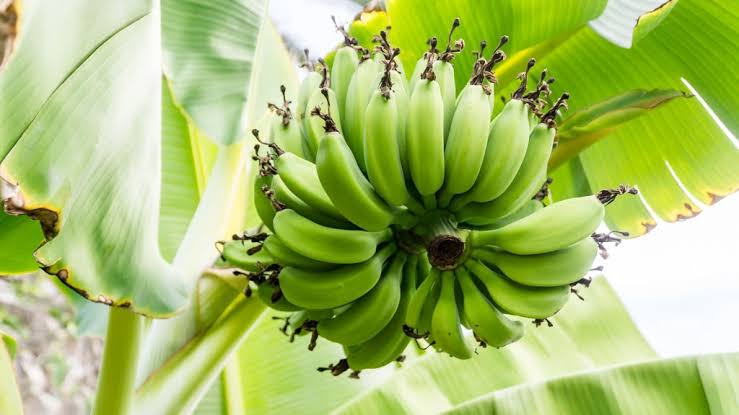
Characteristics
- Appearance: small to medium-sized fruits
- Size: 15 to 17 centimeters in length
- Color: matures from bright green to golden yellow
- Shape: cylindrical, straight to slightly curved shape with pointed ends
- Commonly Cooked: Yes
- Served Raw: Yes
- Availability: Year-round
8. Lady Finger Bananas
Lady Finger bananas grow on tall, slender trees that can reach anywhere from 5 to 25 feet in height. They are thinner than the more common cavendish bananas and have a cigar-like shape. They grow up to 5 inches long and are roughly half an inch in diameter. Lady Finger bananas have thin, bright yellow skins that will develop dark flecks when fully ripe. The fruit has a creamy consistency, with a sweeter flavor than common bananas.
Lady Finger bananas are good for fresh eating, as well as adding to baked goods or smoothies. The thin fruits do not oxidize as quickly as the more common banana, so they are perfect for fruit salads. If Lady Finger bananas are slightly overripe, they are ideal for a loaf of banana bread.
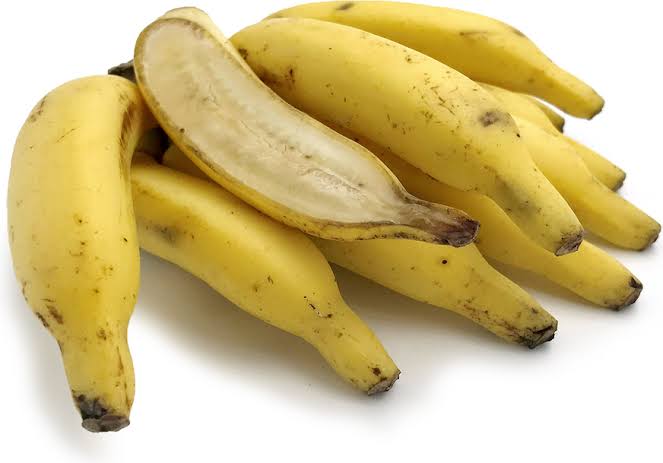
Characteristics
- Appearance: have thin, bright yellow skins that will develop dark flecks when fully ripe.
- Size: 5 inches long and are roughly half an inch in diameter.
- Color: matures from bright green to golden yellow
- Shape: have a cigar-like shape
- Commonly Cooked: Yes
- Served Raw: Yes
- Availability: Year-round
9. Blue Java Bananas
Blue Java bananas have a silver-blue matte sheen when young and warm, canary yellow hue when ripe. They are small, rectangular-like and plump compared to common bananas. The peel is very delicate and bruises easily, underneath is a snow-white flesh with the texture of ice cream when ripe. Its flavor is reminiscent of sweet honey and vanilla custard.
Blue Java bananas are best suited for dessert applications. Utilize them for all recipes that call for any banana within a dessert: custards, pies, tarts, baked goods such as bread, muffins, cakes and of course, ice cream. Blend them into frostings, smoothies, purees and whipped cream. Complimentary pairings include caramel, vanilla, berries, citrus such as key limes and oranges, nutmeg, cinnamon and pineapples.

Characteristics
- Appearance: silver-blue matte sheen when young and warm, canary yellow hue when ripe.
- Size: 5 inches long and are roughly half an inch in diameter.
- Shape: small, rectangular-like and plump
- Commonly Cooked: Yes
- Served Raw: Yes
- Availability: Year-round
10. Thousand Fingers Bananas
Thousand Fingers bananas look similar to more familiar banana varieties such as Cavendish, but are only 1 and ½ inches long. The skin is green ripening to bright yellow and the flesh paler yellow. Thousand Fingers bananas are seedless. The texture is soft and the flavor is very sweet and similar to the flavor of more standard bananas found in American grocery stores.
The solid green colored Thousand Fingers banana tree grows fast, up to 12 feet tall in just a few weeks. The bunches of fruits grow all along a stem, which itself is 8 to 10 feet long. Each plant produces hundreds or thousands of bananas, as the name suggests.
Use Thousand Fingers bananas similar to Cavendish. Eat raw when ripe, cut up into salads, or use baked into dessert recipes. Combine with oats and chocolate in baked goods, other tropical fruits in fruit salads, and peanut butter for smoothies.

Characteristics
- Appearance: The skin is green ripening to bright yellow and the flesh paler yellow
- Size: A medium banana is about 7 inches long
- Color: Bright green when immature, ripening to bright golden yellow
- Commonly Cooked: Yes
- Served Raw: Yes
- Availability: Year-round
11. Saba Bananas
Saba bananas grow in giant bunches at the top of a tall central stem on large banana palms. Once bunch of Saba bananas can weigh up to 80 pounds. Each ‘hand’ containing up to 20 angled fruits. They are shorter and thicker than a common banana, with a blockier shape and sharply angled sides. Their size ranges anywhere from 7 to 13 centimeters long depending on maturity.
Saba bananas are often harvested while still green though they will mature from green to a deeper yellow color. They have a thick peel, which helps protect them during any shipment. The flesh is white and dense, with a starchy consistency, though it is not as firm as a plantain. Saba bananas offer a rich flavor profile, developing a taste somewhat like a sweet potato when cooked. When ripe they are slightly sweet with hints of citrus and peach.
Saba bananas are primarily used as a cooking banana versus a fresh eating variety. In their immature, green state, they are cooked like a vegetable and used in savory dishes. The sweetness will neutralize any spicy foods. Unlike plantains, they can be eaten raw when mature and yellow.

Characteristics
- Appearance: They are shorter and thicker than a common banana
- Shape: Have a blockier shape and sharply angled sides.
- Size: From 7 to 13 centimeters long depending on maturity
- Color: Bright green when immature, ripening to bright golden yellow
- Commonly Cooked: Yes
- Served Raw: Yes
- Availability: Year-round
12. Kandrian Bananas
Kandrian bananas are smaller fruits, averaging 20 to 25 centimeters in length, and have a squat, straight, to a cylindrical shape with angular edges. The bananas grow in bunches, also known as hands, of up to ten fruits, and the peel is smooth and firm, ripening from green to yellow when mature. The peel is easily removed to reveal white flesh that is dense, soft, thick, and creamy. Kandrian bananas are mildly tart when young, developing a sweet and spicy flavor with notes of custard, vanilla, and cantaloupe as they ripen.
Kandrian bananas are best suited for both raw and cooked applications such as baking, frying, and steaming. The fruits are popularly consumed fresh, out-of-hand for their sweet flavor and soft texture when ripe and can be used as a topping over cereals and porridges, blended into smoothies, frozen and purred into ice cream, or sliced into fruit salads.

Characteristics
- Appearance: Have a squat, straight, to a cylindrical shape with angular edges
- Shape: Have a blockier shape and sharply angled sides.
- Size: Averages 20 to 25 centimeters in length
- Color: Bright green when immature, ripening to bright golden yellow
- Commonly Cooked: Yes
- Served Raw: Yes
- Availability: Year-round
13. Pisang Barangan Bananas
Pisang Berangans are small to medium-sized bananas, averaging 10 to 18 centimeters in length, and have an angular, straight to slightly curved, oblong shape. The fruits grow in upright bunches, and each bunch contains between 12 to 20 bananas.
The peel is smooth, ripening from green to yellow when mature, and as the peel continues to age, it may develop a slight orange hue with black spots and markings. Underneath the semi-thick peel, the ivory to cream-colored flesh is firm with a somewhat starchy, dense consistency, softening as it ripens. Pisang Berangans are best consumed when fully ripe and bear a unique sweet and sour, tropical flavor with subtle acidity.
Pisang Berangans have a balanced, sweet and sour flavor well suited for both fresh and cooked applications such as frying and baking. The bananas are primarily consumed straight, out-of-hand as a snack or dessert, or the flesh can be sliced and used as a topping for banana splits. Pisang Berangans can also be blended into smoothies and used to flavor ice cream.
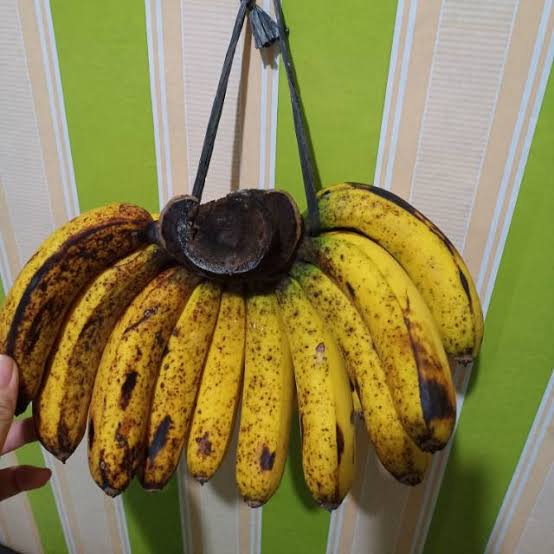
Characteristics
- Appearance: Small to medium-sized bananas
- Shape: Have an angular, straight to slightly curved, oblong shape
- Size: Averages 10 to 18 centimeters in length
- Color: Bright green when immature, ripening to bright golden yellow
- Commonly Cooked: Yes
- Served Raw: Yes
- Availability: Year-round
14. Isla Bananas
Isla bananas are small to medium in size, averaging 7-10 centimeters in length, and are elongated in shape with a slight curve, angular edges, and a wide circumference. The smooth, semi-thick, peel ripens from green to yellow and may have some brown streaks or spots across the surface as it matures. Underneath the peel, the pulp is light pink to pale red with a creamy, soft, and slightly mealy texture. Isla bananas are aromatic and have a mild, sweet flavor.
Isla bananas are best suited for both raw and cooked applications such as baking, boiling, and frying. When raw, the fruit should be left to mature until the peel develops brown-black markings and the peel can be easily removed revealing the pink flesh. When cooked, Isla bananas can be sliced thin and then baked or fried to create a crunchy chip, or they can be boiled and served with cooked meats or fish as a side dish.
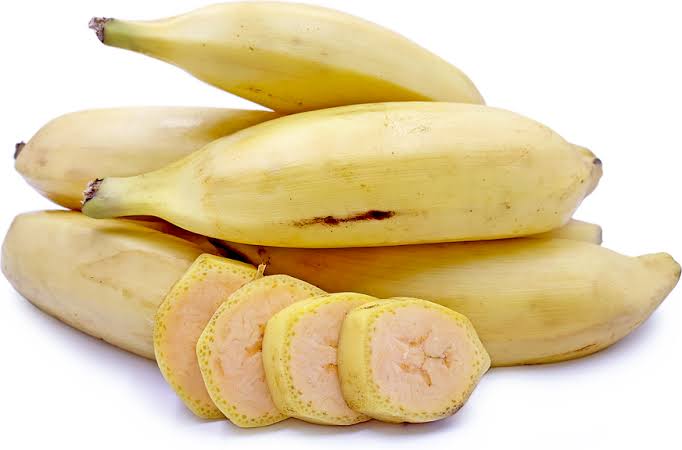
Characteristics
- Appearance: Small to medium-sized bananas
- Shape: Elongated in shape with a slight curve, angular edges, and a wide circumference
- Size: Averages 7 to 10 centimeters in length
- Color: Bright green when immature, ripening to bright golden yellow
- Commonly Cooked: Yes
- Served Raw: Yes
- Availability: Year-round
15. Praying Hands Bananas
Praying Hands bananas are just that, two adjacent “hands” of bananas fused where they meet, to create the appearance of “praying hands.” Each hand is typically made up of 6 to 7 individual fruits, fused to each other, mirrored by another equally-fused hand of fruits. Each medium-sized banana separates easily from the bunch when fully ripe, the thick skins adhering only slightly. The flesh is a bright yellow-white, firm and starchy. They have a semi-sweet flavor with a hint of vanilla.
Praying Hands bananas are eaten both raw and cooked. They are eaten raw when the bananas are over-ripe and very soft. They can be cooked at any stage of maturity but most often when somewhat or mostly yellow. The flavor lends best to savory applications. They are prepared like plantains, made into fritters or fried, smashed and refried.

Characteristics
- Appearance: Small to medium-sized bananas
- Shape: Two adjacent “hands” of bananas fused where they meet, to create the appearance of “praying hands.”
- Size: Averages 7 to 10 centimeters in length
- Color: Bright green when immature, ripening to bright golden yellow
- Commonly Cooked: Yes
- Served Raw: Yes
- Availability: Year-round
16. Pisang Tanduk Bananas
Pisang Tanduk bananas are long and curved, averaging 5-8 centimeters in diameter. The horn-shaped fruit has a thick peel that is green when immature and yellow when ripe. The inner flesh is yellow to cream-colored and has a semi-firm texture. When green, Pisang Tanduk bananas are slightly sour, but when mature and cooked, they become creamy and sweet.
Pisang Tanduk bananas are best suited for cooked applications such as frying, boiling, baking, and steaming. They are popularly sliced, pan fried or deep fried, and served with a peanut sauce, with eggs, or stuffed with sweetened beans. They can be steamed and served with grated coconut, and they can also be sliced thin and baked into chips as a snack.

Characteristics
- Appearance: Long and curved
- Shape: Horn-shaped fruits
- Size: Averages 5 to 9 centimeters in length
- Color: Bright green when immature, ripening to bright golden yellow
- Commonly Cooked: Yes
- Served Raw: Yes
- Availability: Year-round
17. Pisang susu Bananas
Pisang Susus are small fruits, averaging 10 to 12 centimeters in length, and have a squat, straight to slightly curved shape. The bananas grow in compact hands of up to 25 fruits, and each stalk can produce 1 to 8 hands.
The peel of the fruit is smooth and thin, ripening from green to bright yellow, and can be solid or covered in many small black specks. Underneath the surface, the flesh is ivory to white and has a soft, seedless, smooth, and slightly sticky consistency. Pisang Susus are aromatic and have a fruity, sweet, and honeyed flavor.
Pisang Susus are best suited for fresh applications as their sweet flavor is showcased when consumed straight, out-of-hand. The bananas can be consumed as a breakfast item or afternoon snack, or they can be sliced and mixed into fruit salads.
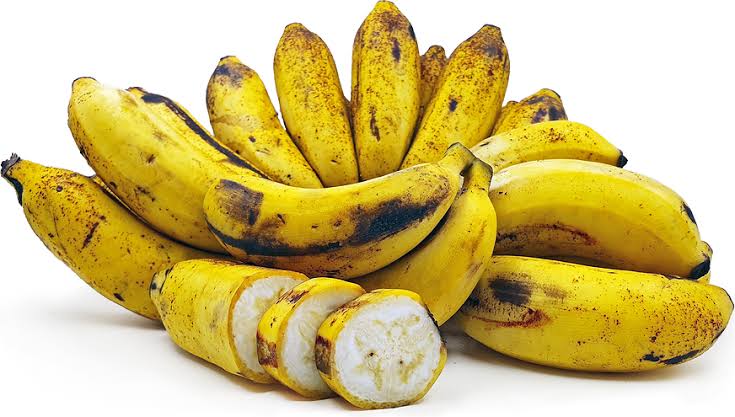
Characteristics
- Appearance: Small fruits
- Shape: have a squat, straight to slightly curved shape
- Size: Averages 10 to 12 centimeters in length
- Color: Bright green when immature, ripening to bright golden yellow
- Commonly Cooked: Yes
- Served Raw: Yes
- Availability: Year-round
18. Brazilian Dwarf Bananas
The Brazilian Dwarf banana is, as its name implies, a small scale tree that produces short plump fruits. The trees usually begin producing when they are between 2 and 3 meters tall and yield bananas about half the size of the Cavendish, the predominant grocery store variety. A golden yellow when fully ripe, their texture is slightly firm like that of a ripe plantain, yet still offers a silky mouthfeel. They are superiorly sweet but balanced with a hint of tart green flavors, and often regarded as one of the best tasting banana varieties on the market.
Brazilian Dwarf bananas may be used in the same manner as any other sweet banana variety. They are perfectly sized for a lunch box or just a small snack for young children. They can be utilized as an ingredient in smoothies, yogurts, cakes, muffins, breads, ice cream, cookies, pudding and more.

Characteristics
- Appearance: Small plumpfruits
- Shape: have a squat, straight to slightly curved shape
- Size: Averages 5 to 10 centimeters in length
- Color: Bright green when immature, ripening to bright golden yellow
- Commonly Cooked: Yes
- Served Raw: Yes
- Availability: Year-round
19. Horn Bananas
Horn bananas are medium to large in size, averaging 30-35 centimeters in length, and are elongated and angular in shape with slightly pointed ends. The thick, tough peel is smooth with pronounced ridges running the length of the fruit and matures from green to bright yellow with some brown spots. Underneath the peel, the flesh is dense, pale yellow to cream-colored, and is seedless or contains a few, dark brown undeveloped, edible seeds. Horn bananas have a firm and starchy consistency with a very mild, neutral flavor.
Horn bananas are best suited for cooked applications such as boiling, baking, steaming, grilling, or frying and can be used when unripe or ripe. The starchy flesh softens with cooking, and sugar, cinnamon, apple juice, or coconut milk can be incorporated into the cooked dish for added flavor. Horn bananas can also be dried and ground into a flour which is used for ice creams, bread, baby food, and cakes, or it can be sliced and baked into chips, pickled, or chopped and mixed into relishes.

Characteristics
- Appearance: Medium to large bananas
- Shape: Elongated and angular in shape with slightly pointed ends.
- Size: Averages 20 to 25 centimeters in length
- Color: Bright green when immature, ripening to bright golden yellow
- Commonly Cooked: Yes
- Served Raw: Yes
- Availability: Year-round
20. Guineo Bananas
Guineo bananas are small to medium-sized fruits, averaging 15 to 20 centimeters in length, and have an elongated, curved to straight, cylindrical shape with angular edges. The peel is semi-thick, smooth, waxy, and dark green when young, maturing to a golden yellow hue when ripe. The peel is also stiff and tightly adhered to the flesh when green, sometimes bearing black marks and spots due to external damage.
Underneath the peel, the flesh is firm, cream-colored to pale pink, and dense with a starchy consistency. Guineo bananas must be cooked when unripe and develop a soft, creamy texture with a neutral, subtly sweet flavor. The fruits can also be left to fully ripen, allowing the starch in the flesh to convert into sugars, creating a sweeter taste.
Guineo bananas are primarily utilized young and green, incorporated into cooked applications such as frying, boiling, baking, and grilling. The bananas contain a starchy, firm texture when raw, making them unsuitable for fresh consumption, but when they are cooked, they develop a soft consistency and neutral flavor to complement accompanying flavors.

Characteristics
- Appearance: Small to medium-sized fruits
- Shape: Have an elongated, curved to straight, cylindrical shape with angular edges
- Size: Averages 10 to 15 centimeters in length
- Color: Bright green when immature, ripening to bright golden yellow
- Commonly Cooked: Yes
- Served Raw: Yes
- Availability: Year-round
21. Hopa Bananas
Hopa bananas widely vary in size and shape, depending on the specific variety, and generally have a bulbous, cylindrical shape with squared, blunt, and curved ends. The fruits range from elongated to squat, and the semi-thick peels are smooth, waxy, and rounded, with a few angular ridges extending the length of the fruit. Hopa bananas are edible in both their green and yellow stages, and in the center of the flesh, there is a line of black seeds.
Green Hopa bananas have a firm, somewhat starchy texture that must be cooked to develop a subtly sweet, mild flavor with a creamy, dense consistency reminiscent of a potato. As the fruit ripens, the peel transforms into a golden yellow hue and displays dark brown spots, a signal that the pulp can be eaten fresh. Yellow or mature Hopa bananas convert starches into sugar, creating a soft and tender pulp with a sweet, neutral flavor.

Characteristics
- Appearance: Small to medium-sized fruits
- Shape: Have a bulbous, cylindrical shape with squared, blunt, and curved ends
- Size: Averages 10 to 15 centimeters in length
- Color: Bright green when immature, ripening to bright golden yellow
- Commonly Cooked: Yes
- Served Raw: Yes
- Availability: Year-round
22. Pitogo Bananas
Pitogo bananas are tiny fruits, averaging 2 to 4 centimeters in diameter and 4 to 6 centimeters in length, and have an oval to tear-drop shape with a broad, curved non-stem end, similar in appearance to a fig. The peel is semi-thick, ripening from green to bright yellow with some brown discoloration, and is primarily smooth with a light waxy feel and a few rough patches.
When ripe, the peel is easily removed, revealing seedless, pale yellow to ivory flesh with a sticky, dense consistency. Pitogo bananas are firm when young with a sweet-tart, slightly astringent flavor, and as the fruits mature, they develop a softer, creamier texture with a sweet, bright, and tangy, tropical taste.
Pitogo bananas are a dual-purpose variety that can be consumed fresh or cooked. When raw, the fruits are primarily eaten straight, out-of-hand, and are favored for their bite-sized nature. Pitogo bananas can also be mixed into fruit salads, sliced as a topping over ice cream or oats, blended into smoothies, used to flavor ice cream, or dipped into chocolate and frozen as a sweet treat.

Characteristics
- Appearance: Tiny small fruits
- Shape: Have an oval to tear-drop shape with a broad, curved non-stem end
- Size: Averages 4 to 6 centimeters in length
- Color: Bright green when immature, ripening to bright golden yellow
- Commonly Cooked: Yes
- Served Raw: Yes
- Availability: Year-round
23. Nam Wah Bananas
Nam Wah bananas grow in paired bunches along the giant herb’s central raceme, or fruit stalk. Each pair of hands contains up to 20 medium-sized, plump fruits, measuring 10 to 13 centimeters. The thin peel matures from green to yellow and is fully ripe when the peel is nearly black. The flesh is fragrant and dense with a juicy consistency and sweet flavor. Underripe or green Nam Wah bananas may have a slightly acidic taste.
Nam Wah bananas are used raw but are most often cooked. They are usually picked when still green with only a hint of yellow. Green bananas are used like a vegetable and served with fish, in stews and paired with meats. When just fully yellow, Nam Wah bananas are peeled, halved and smashed then battered and fried.

Characteristics
- Appearance: Grow in paired bunches along the giant herb’s central raceme, or fruit stalk
- Shape: Have an elongated, curved to straight, cylindrical shape with angular edges
- Size: Averages 10 to 13 centimeters in length
- Color: Bright green when immature, ripening to bright golden yellow
- Commonly Cooked: Yes
- Served Raw: Yes
- Availability: Year-round
24. Plantains
Plantains (Musa paradisiaca) are a type of cooking banana and are also called green bananas. The distinguishing feature of plantains is that they are not as sweet as other types of banana. The reason plantains are used for cooking is they are quite starchy and not as flavorful as traditional bananas.
Plantains are often cooked before they ripen fully. Their hard, firm texture and stiff peel hold up well when fried, boiled, or steamed. You can also leave plantains to ripen where they will turn a typical ‘banana’ color. The flesh of ripe plantains is much softer, but they still lack the sweetness of dessert bananas.
In many tropical countries, plantains are part of the staple diet. They are a popular food in the Caribbean, Central and West Africa, and Southeast Asia.

25. Goldfinger Bananas
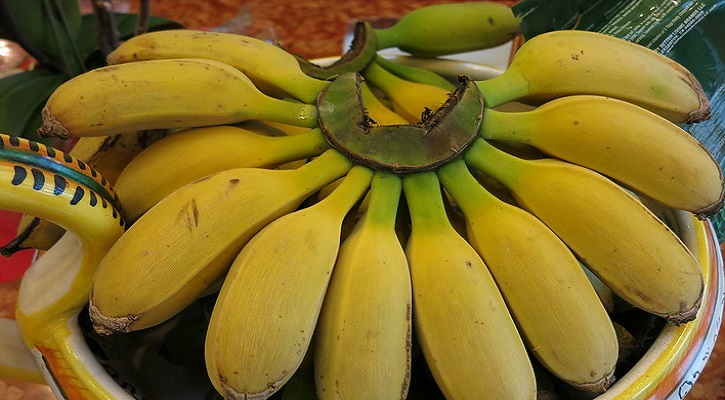
Goldfinger banana is a cross between Cavendish and Ladyfinger. This type has more flavor and texture than other varieties. The fruit is ready to be harvested once the bananas lose their ridges, become more rounded, and when the black withered remains of the flowers at the end of the bananas are dry and crumbly
The dense goldfinger bananas are cut into chunks, boiled and used to make puddings and creams, or mashed and added to baked goods. They are eaten raw as a snack or dessert when fully ripe and the flesh has softened.